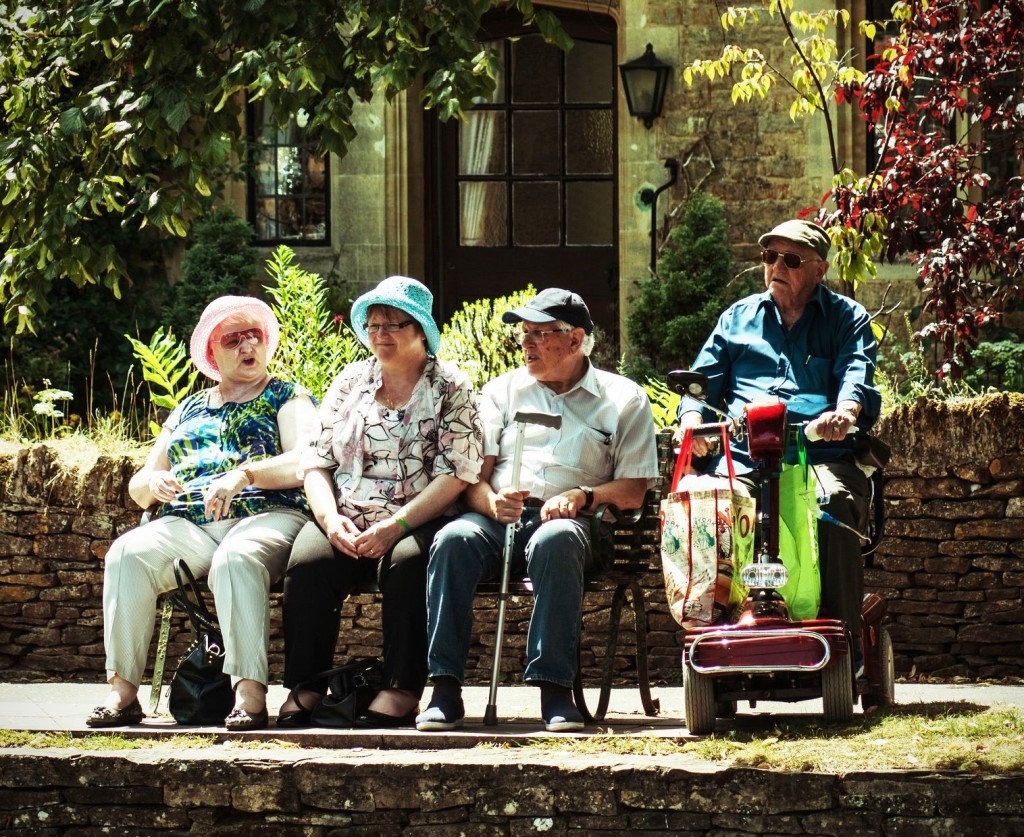
Back in May I interviewed Judi Bonilla, a San Diego gerontologist, as research for my articles about modern old age for Bay Alarm Medical. I also read tons of articles about seniorhood and society’s response to its own greying. These leftover notes have been sitting around on my computer since then, so I figured… let them see the light! I didn’t organize this stuff into an actual article, so your interest may be limited if you’re not already obsessed with aging. If you happen to be writing about this, feel free to use the material! Just link back to me. Or get in touch — whatever.
Conversation
Family-member caregivers are usually women, primarily daughters and daughters-in-law. Judi Bonilla told me, “Most people don’t identify themselves as a caregiver.” They see their role as “helping Mom or Dad” and may underestimate the emotional and physical toll of caring for an elderly person. They view it as their duty to give back to the people who raised them and supported them as children.
Because of this, they may not reach out to take advantage of resources for caregivers. They’re just trying to cope with the day-to-day reality, which makes it hard to step back and take a longer perspective on what they’re doing. Most family caregivers work full-time, and they usually do not tell their employers. Bonilla explains the mindset: “You step up to help your parents. It’s what you do. You automatically fall into that role.”
Bonilla’s perspective, having lived in foreign countries, is that Americans are especially focused on what we see right now. Older people are not as visible as children, which is why there are so many more pediatricians than gerontologists. This is part of why preventative care, laying the foundations of health, hasn’t been a focus for our medical system. For instance, southern California is not pedestrian-friendly. This leads to people being less physically active throughout their lives, which leads to a higher risk of certain chronic afflictions.
I asked about assisted living. Bonilla mentioned that her neighbor is currently leaving her home to move to a facility where she’ll have extra support. It’s good because people need more services. The neighbor is making the decision on her own, which is crucial. Bonilla is optimistic about the diversity of medical options. She explains, “There is no one magic formula.” We need to find a multiplicity of solutions for different people with different needs.
Aging is scary. But you can learn to be unafraid, for your loved ones or yourself. A shift in perspective can ensure that the last fifteen years of a person’s life will be just as rich and fulfilling as the first decades were.
Collected Quotes
“In dealing with the guilt brought on by our mixed feelings — we love him; he’s ruining our lives — I realize we may have overcompensated to his detriment.”
“I fully understood something I observed at work all the time — how it was possible to love a frail relative, prioritize his comfort and well-being, and yet repeatedly find oneself doing things that felt awful to everyone.”
“Weighing the End of Life” by Louise Aronson.
“the public, by contrast, has a largely negative, individualist, and fatalistic view of aging. They also aren’t aware of how much and how permanently the country is aging, how social and economic choices influence the experience of aging, or the pervasiveness of age bias.”
“What we talk about when we talk about aging” by Louise Aronson.
“Residents thinking about medical specialties often consider geriatrics depressing, even though surveys of practicing physicians show that geriatricians find their work very satisfying.”
“Even Fewer Geriatricians in Training” by Paula Span.
“Almost one-third of respondents (29%) who reported frequent healthcare discrimination developed new or worsened disability over four years, compared to just 16.8% of those who infrequently experienced it and 14.7 % who never experienced it.”
“1 in 5 Adults Report Age Discrimination in Healthcare Settings” by Alexandra Wilson Pecci.
“Older people who move into assisted living and other forms of supportive housing are primarily seeking ways to reduce unmet needs. Occasionally, someone moves because he feels lonely or she is trying not to burden her children. But usually, people stay in their homes as long as they can until unmet needs pile up.”
“Unmet Needs Continue to Pile Up” by Paula Span.
“it is healthier to accept doing what is necessary to keep oneself functioning and comfortable than to try to live up to some image of youth.”
“Reluctance to use Hearing Aids” by Al Martin.
“Aging in place doesn’t happen by accident, it’s by design and it requires you to be prepared for a range of different scenarios.”
“Aging in Place: Rights and Wrongs!” by Rosanna Fay.
“The curriculum of the Academy of Aging does not offer elective diseases; the unseen faculty chooses them for us.”
“Living and Learning: The Academy of Aging” by Daniel Callahan.